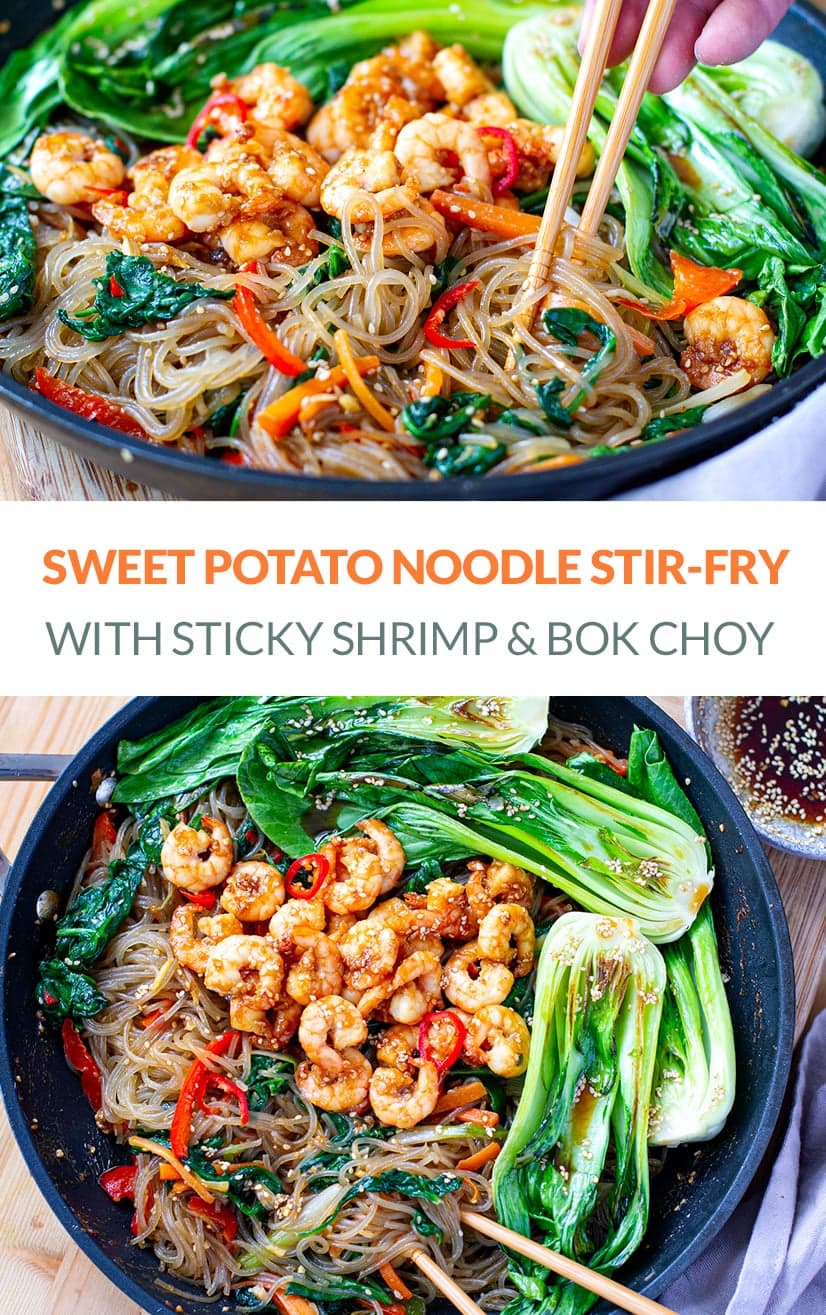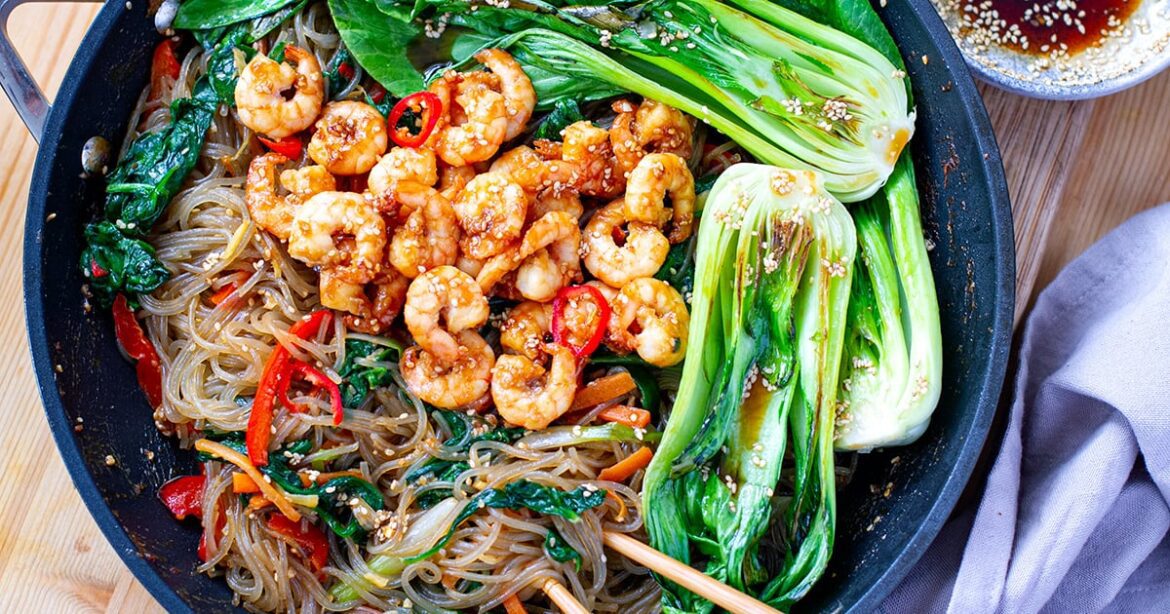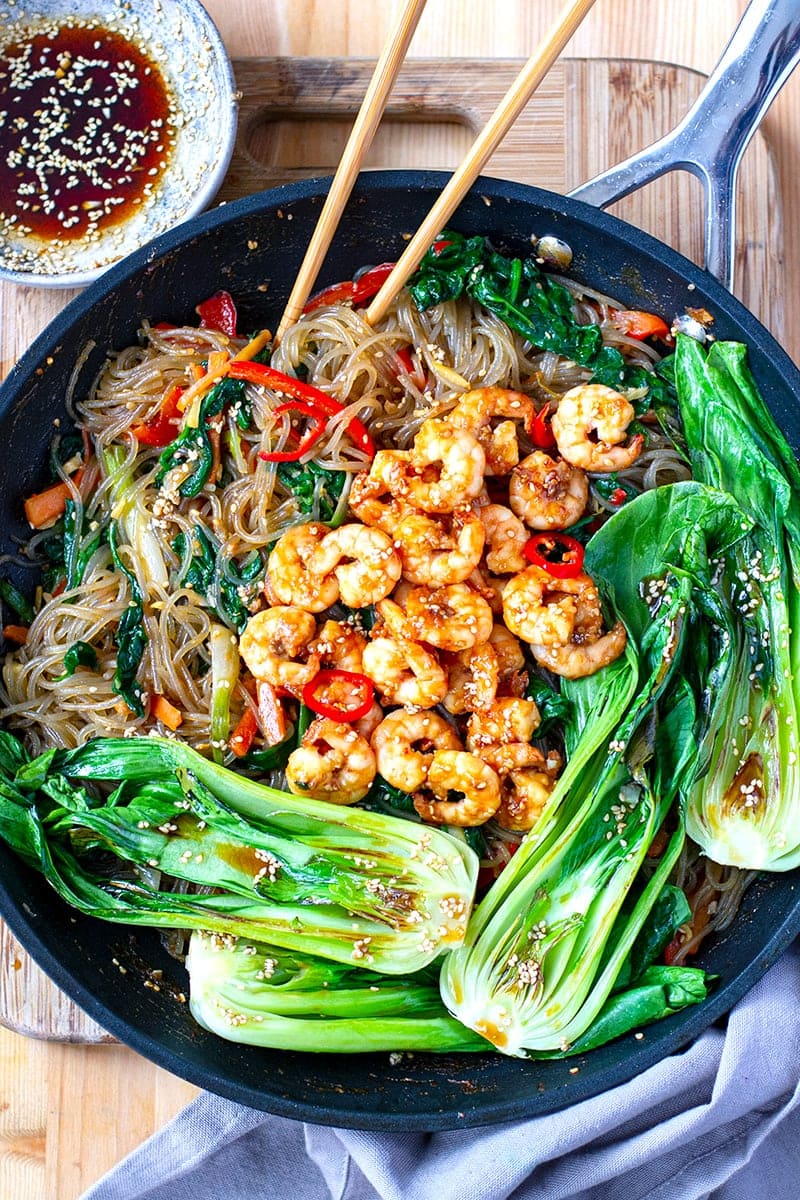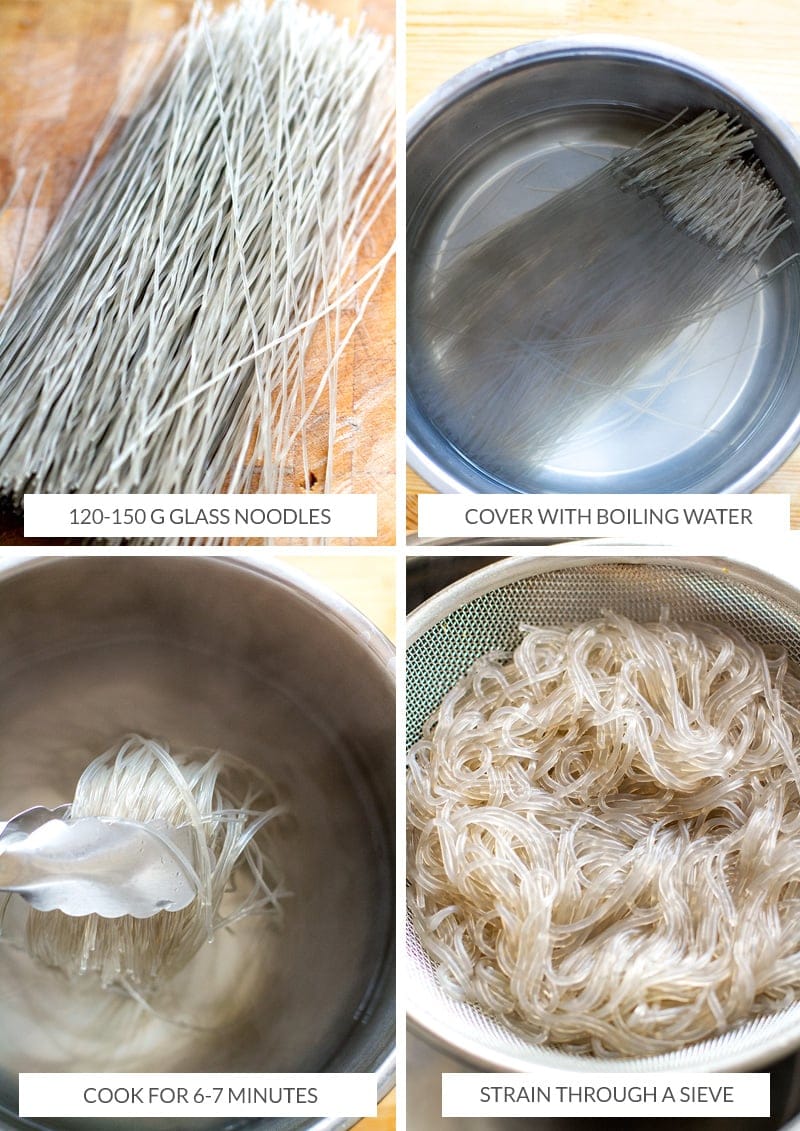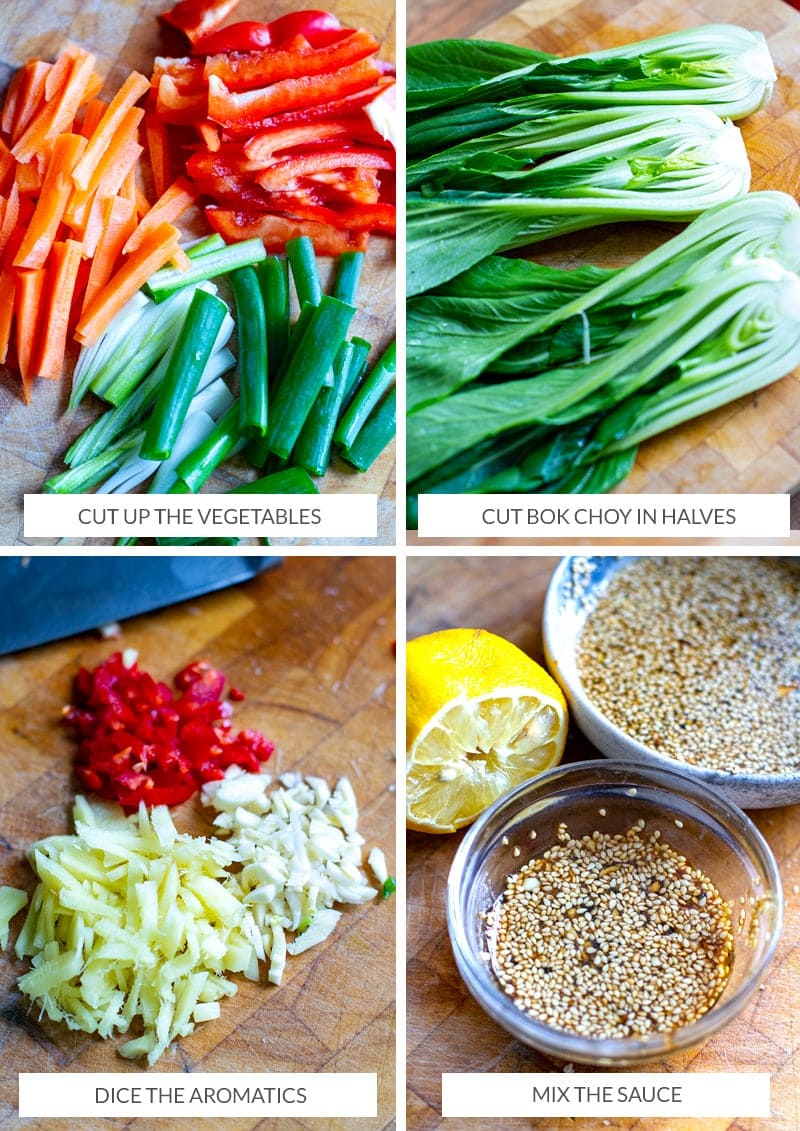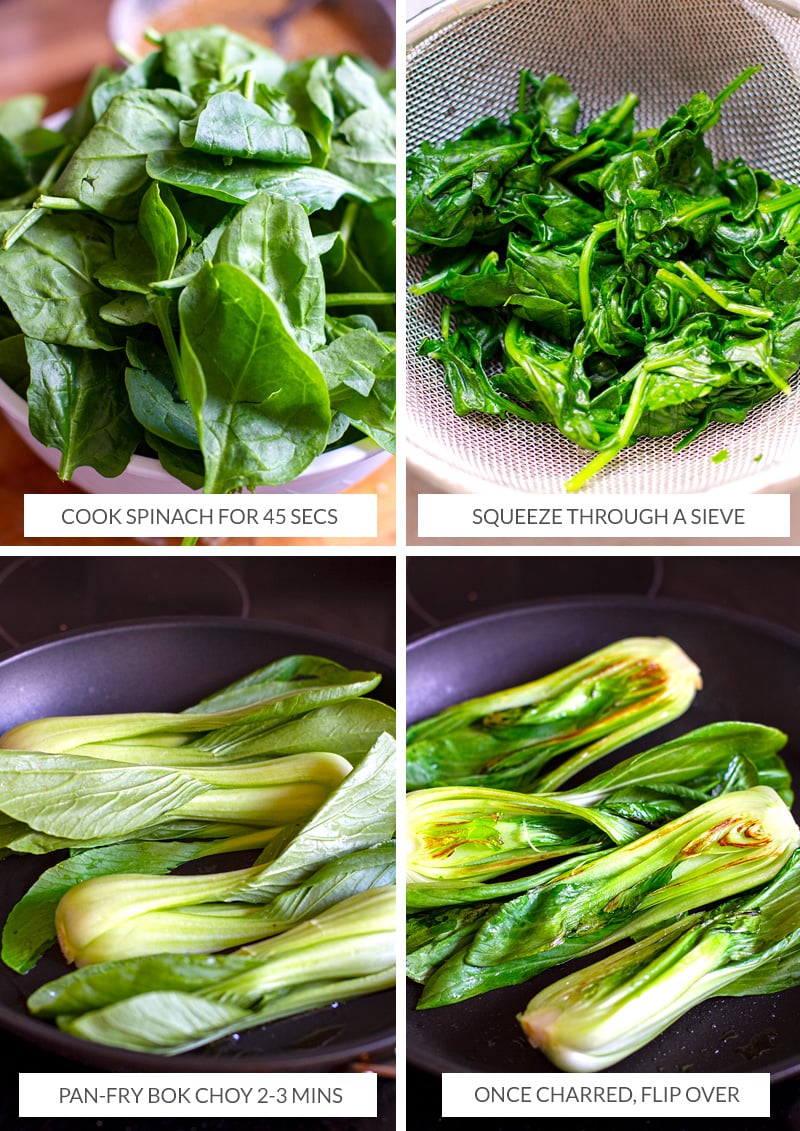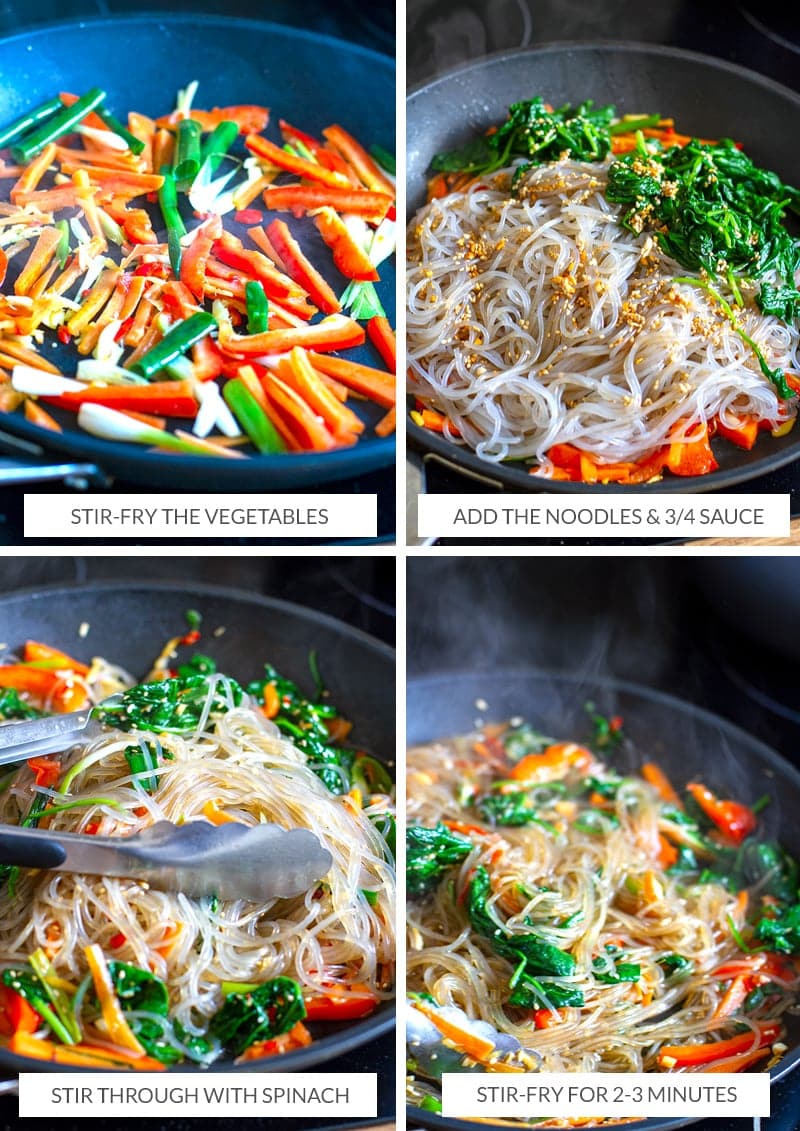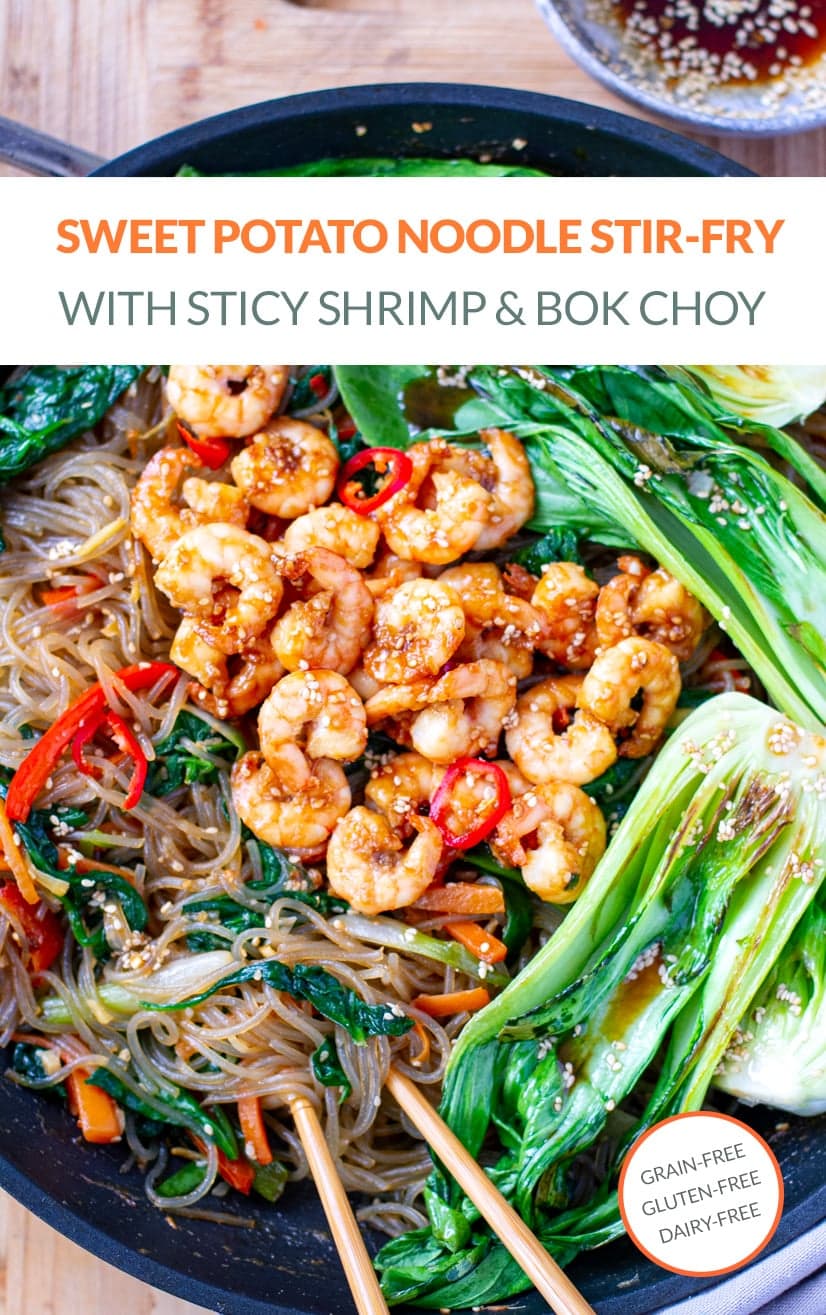Table of Contents
This stir-fry recipe with sweet potato glass noodles, sticky sesame shrimp and bok choy is adapted from a classic Korean dish called Japchae. It’s one of my favourite noodle dishes from this Asian cuisine and I love making it at home with whatever I have on hand. It’s super nutritious, gluten-free, grain-free and paleo-friendly. Find step-by-step photos below the recipe card. Please leave a rating and a comment below if you cook this dish!
Have you ever had sweet potato glass noodles? What about the Korean dish called Japchae? Well, in today’s recipe you get to try both of them. It’s a delicious dinner meal of stir-fried vegetables and glass noodles in sesame sauce and some added sticky shrimp (prawns) and some bok choy for extra greens. There are a few stages to making this dish and might seem like a bit of effort, but trust me all the steps are easy and the final result is worth it.
WHAT ARE SWEET POTATO GLASS NOODLES?
Sweet potato noodles are sometimes called glass noodles and you will usually find them on Korean menus, such as in a dish called Japchae. These are dried noodles made with sweet potato starch and water. They are slightly grey and transparent with a firm and slick texture and a slightly sweeter taste than regular rice noodles. Look for these noodles in your local Asian grocer or online (like these on Amazon).
To prepare sweet potato glass noodles, cook them in boiling, salted water for around 6 minutes, stirring frequently. Then drain and rinse under cold water before using in salads, soups or stir-fries. Please note that these are not the same as spiral sweet potato noodles made from the fresh root vegetable.
Per 50 grams of uncooked glass noodles, you’re looking at 175 calories, 45 grams carbs, <1 gram fat, 0 grams fibre and protein, some calcium and iron. They’re not nutrient-dense but are used rather as a vehicle for other nutritious foods like protein and veggies. They are, however, quite tasty!
If you can’t get Korean glass noodles, use any other grain-free or gluten-free noodles. Check my ultimate gluten-free and grain-free noodle options here.
MORE NUTRITIOUS ASIAN RECIPES
Description
Learn how to make a delicious and healthy sweet potato glass noodle stir-fry with vegetables, sticky shrimp and sesame sauce, inspired by the Korean Japchae dish. This recipe is gluten-free, grain-free and paleo0-friendly. See step-by-step photo instructions below.
- Bring a large pot of water to a boil. I use a kettle to speed things up usually. Place about 120 grams of sweet potato glass noodles in the hot water, add a pinch of salt and stir through. There should be enough water to cover the noodles but they won’t expand a great deal, so you don’t need a full pot. Cook for 6-7 minutes.
- Strain the noodles (you can reserve this hot water for the spinach step below), then leave them in some cold water to cool, while you prepare the rest of the ingredients.
- Boil a little more water either in a small pot or in a kettle. Add spinach to a pot and cover with boiling water. Cook for 45-60 seconds, stirring around. Strain and cool, then squeeze gently to remove excess liquid. Set aside.
- Cut the carrot in halves and then slice into matchsticks or strips. Cut the spring onions (scallions) and sweet red peppers into strips as well. Thinly slice or chop the ginger and chilli and set aside. You can also chop the garlic for the sauce at this stage.
- Wash the bok choy well between the leaves and cut in halves. You can leave the firm part of the root. Set aside.
- Mix the sauce ingredients in a bowl. Take 3 tablespoons and add to another bowl, which will use as the sauce for the shrimp.
- Prepare the prawns. If using frozen prawns, soak them in warm water for 5 minutes and pat dry with a paper towel. If using shelled fresh prawns, deshell and remove the heads. We are now ready to cook our stir fry.
- Add a tablespoon of oil to a large frying pan and heat over high heat. Once hot, add the bok choy halves, cut side down. Cook for 1.5-2 minutes until charred, then flip over and cook for another minute. Transfer to a plate.
- To the same frying pan, add the onions, carrots, peppers, ginger and chili and another spoonful of oil. Stir-fry over high heat for 1-2 minutes.
- Strain and add the noodles to the frying pan together with wilted spinach. Add the sauce, reserving the 3 tablespoons that we saved for the prawns. Stir through and cook over medium-high heat for 2-3 minutes. Keep stirring, allowing the sauce to darken and caramelise slightly. The noodles will also darken as the sauce gets thicker. Have a quick taste and if needed, add a little more Tamari sauce or coconut aminos and sweet syrup (in equal parts, so if you add more salt, make sure the sweetness is balanced). Remove all of the noodles and vegetables to a bowl or a plate.
- Add the prawns to the frying pan and bring the heat back to high. Pour over the reserved sauce and cook, stirring frequently, for 2-3 minutes. The sauce will thicken and caramelise, coating the prawns with sticky glaze. Once it’s all thick and sticky, add the stir-fried noodles back in and combine. You can also remove the prawns first and serve them on top of noodles. Serve bok choy on top, drizzle with a little extra Tamari sauce or lemon juice and sesame oil.
Notes
You can use frozen prawns/shrimp, simply defrost in warm water for 5-10 minutes.
Coconut aminos are less salty and have a little sweetness compared to Tamari gluten-free sauce, so if using aminos, taste for seasoning. Add a little extra regular salt or fish sauce or maybe reduce the sweetener for that perfect salt and sweetness balance.
Rice noodles would work well instead of glass noodles. For a low-carb version, use spiralized zucchini noodles or zero-carb noodles like Kojac shirataki.
Nutrition
- Serving Size: 1 cup noodles with vegetables, shrimp and some bok choy
- Calories: 600
- Sugar: 29.1 g
- Sodium: 1318.4 mg
- Fat: 26.4 g
- Saturated Fat: 3.9 g
- Carbohydrates: 75.2 g
- Fiber: 8.8 g
- Protein: 24.9 g
- Cholesterol: 105.5 mg
HOW TO MAKE JAPCHAE GLASS NOODLE STIR-FRY
Before you start cooking, make sure to prepare all the ingredients as that’s what will take the longest. Once everything is ready to go, the stir-frying part is pretty quick. You can use a variety of vegetables but I am going with the traditional spring onions (scallions), carrots and sweet red peppers and adding some bok choy on the side.
You should also dice up all your aromatics: chilli, ginger and garlic (for the sauce). Mix the sauce we will use during cooking and set aside. You will use 2/3 of the sauce in the stir-fry and 1/3 with the shrimp.
One of the reasons I love this stir-fry recipe is the amount of dark leafy greens used. You will need a lot of fresh spinach, which needs to be lightly wilted in boiling water. Squeeze it and set aside. This will go into the stir-fry.
Pan-fry the bok choy halves in a large pan until charred and set aside for later. These will go on the side of our dish.
Okay, now that we have everything ready, begin the stir-frying process. Start with the veggies, then add the noodles, spinach and 2/3 of the sesame sauce and cook for 2-3 minutes until the sauce starts to caramelise and noodles get a little darker.
Remove the stir-fried noodles to another bowl and add the shrimp with the remaining sauce to the hot frying pan. Cook, stirring frequently, until the sauce and the shrimp get nice and sticky. I like to return the noodles to the pan, top with the cooked shrimp and add bok coy on top. I drizzle bok choy with a little lemon juice and coconut aminos.
SAVE THIS GLASS NOODLE STIR-FRY RECIPE TO PINTEREST
